Vodka Rigatoni
Rigatoni...With Vodka Sauce

What Is Vodka Rigatoni?
Vodka rigatoni is a popular Italian-American pasta dish that typically consists of rigatoni pasta cooked in a creamy tomato sauce that is flavored with vodka, onions, garlic, and crushed red pepper flakes. The sauce is usually made by simmering diced onions and minced garlic in olive oil until they are soft and translucent, then adding tomato sauce, cream, and vodka. The vodka is added to the sauce for flavor, and also to help release the flavors of the tomatoes.
Ingredients For Vodka Rigatoni


Produce
1 Red Onion
4 Garlic Cloves
Fresh Basil
Refrigerated
1 Cup Heavy Cream
1/2 Cup Parmesan Cheese

Grocery
1/2 Cup Vodka
6 oz Tomato Paste
1/4 Cup Olive Oil
16 oz Rigatoni

Spices
1/2 tsp Crushed Red Pepper Flakes
1/2 tsp Paprika
1/2 tsp Salt
1/2 tsp Pepper
How To Make Vodka Rigatoni
Step 1
Cook Pasta
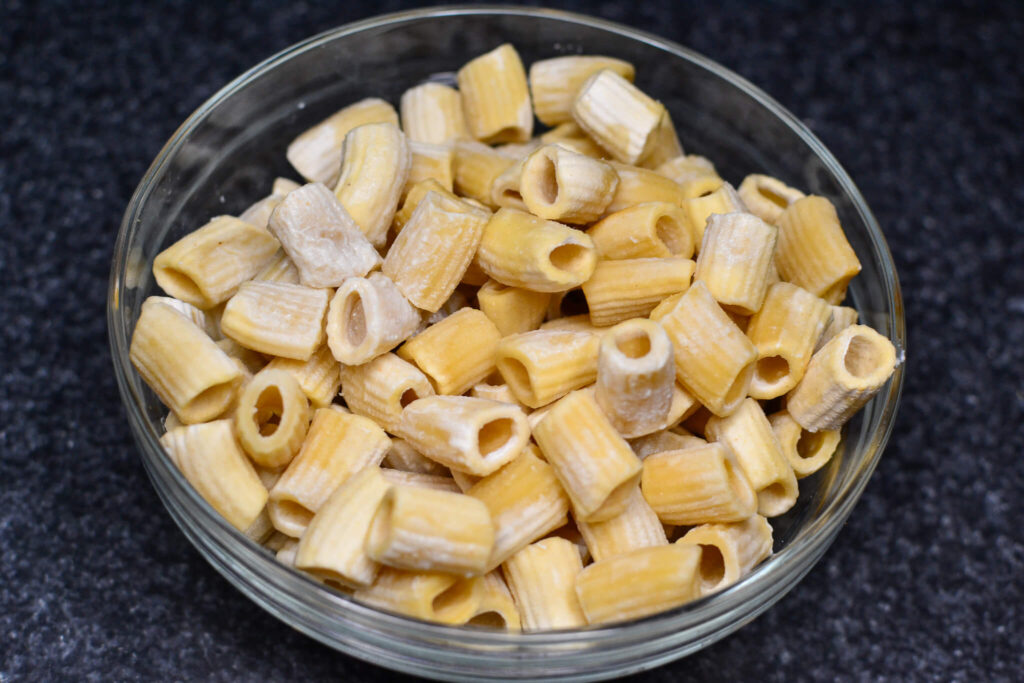
The foundation of any great pasta dish is high-quality pasta. For this recipe, I’m using fresh rigatoni from Maria’s Pasta Shop in Utica. Their pasta delivers an unbeatable taste and texture, giving the dish a gourmet touch. Fresh pasta enhances the overall flavor and ensures a satisfying bite, but if it’s not available, don’t worry. Barilla’s Rigatoni is a fantastic alternative. Known for its ridged texture, it’s perfect for holding onto rich sauces like the creamy vodka sauce we’re making.
This dish doesn’t rely on protein, so it’s a great opportunity to focus on the pasta itself. If you’re up for making fresh pasta, now’s the time! But if not, no worries! If you don’t have a local pasta shop or don’t want to make your own, Barilla’s Rigatoni is a solid choice. It’s available at most grocery stores, and the ridged texture works well with sauces.
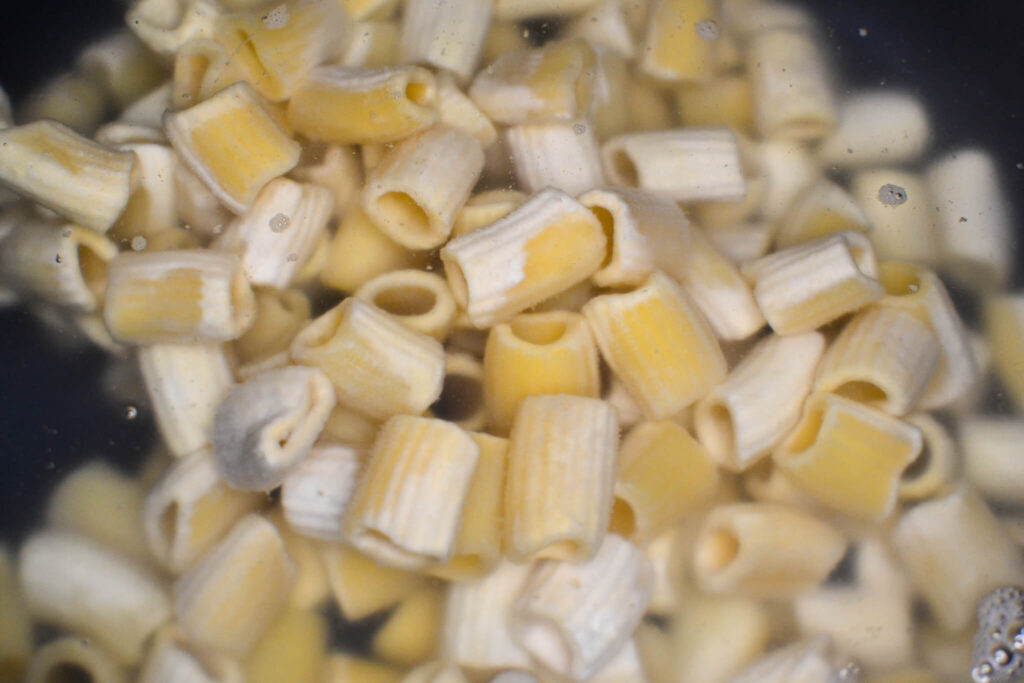
Cooking the pasta to al dente is key. This usually takes 10-15 minutes, depending on the brand and type of pasta you’re using. Start by bringing a large pot of salted water to a rolling boil. The salt not only flavors the pasta but also helps in enhancing the sauce later.

Once the pasta is done, be sure to reserve about 2/3 cup of the starchy pasta water before draining. This starchy water will be a game-changer in achieving the perfect sauce consistency.
Step 2
Prep Produce
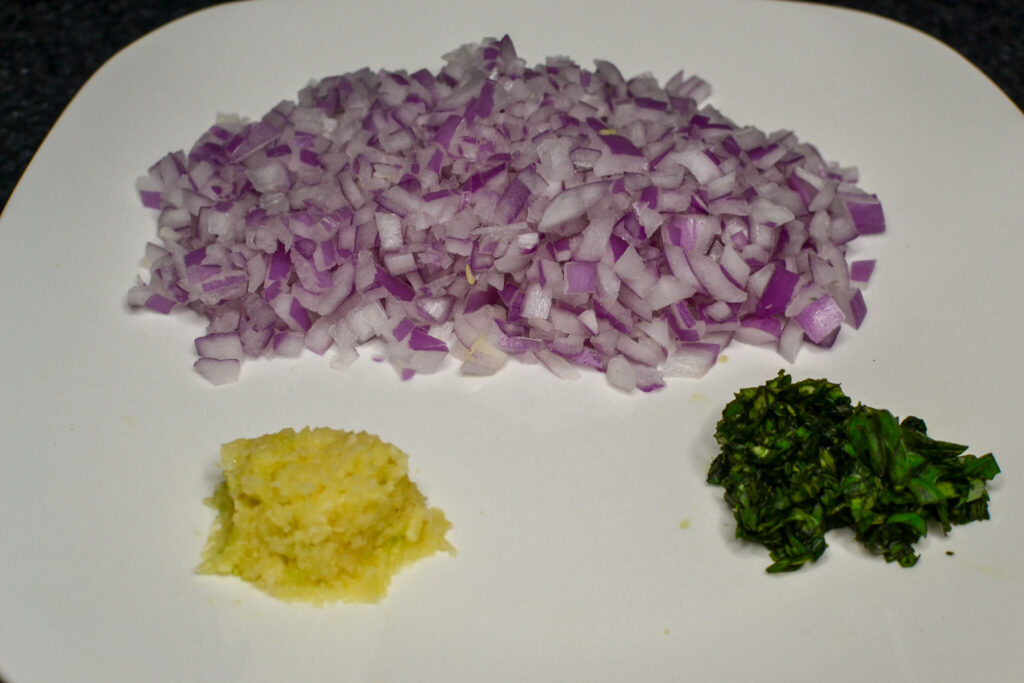
When preparing produce for vodka rigatoni, taking the time to properly dice, mince, and chop ensures that every bite is flavorful and well-balanced. Start with the red onion. Peel off the outer layer, then slice the onion in half from root to tip. Lay each half flat on the cutting board and make horizontal cuts, followed by vertical cuts, creating a fine dice. This allows the onion to soften quickly and evenly in the sauce, releasing its sweet and savory flavor.
Next, move on to the garlic. For mincing, begin by peeling the cloves. To make peeling easier, lightly smash each clove with the flat side of a knife. Once peeled, chop the garlic into small pieces. For a finer mince, run your knife through the chopped garlic repeatedly until it reaches the desired consistency. The minced garlic will infuse the sauce with a rich, aromatic depth.
Finally, the basil. Fresh basil adds a fragrant, herbal note that complements the richness of the sauce. Rinse the leaves under cold water and pat them dry. Stack a few leaves on top of each other, roll them into a tight cylinder, and slice thinly to create chiffonade ribbons. If you prefer smaller pieces, give the ribbons a quick chop.
Step 3
Make Sauce

Now it’s time to bring everything together in the skillet. Start by heating 1/4 cup of olive oil over medium heat. Once hot, add the diced red onion and sauté for about 3 minutes until it turns translucent and starts to soften. This step helps to build the flavor base of the sauce.

Add the minced garlic to the skillet, stirring well to combine. The aroma of garlic and onion cooking together is irresistible and sets the stage for a deeply flavorful sauce.
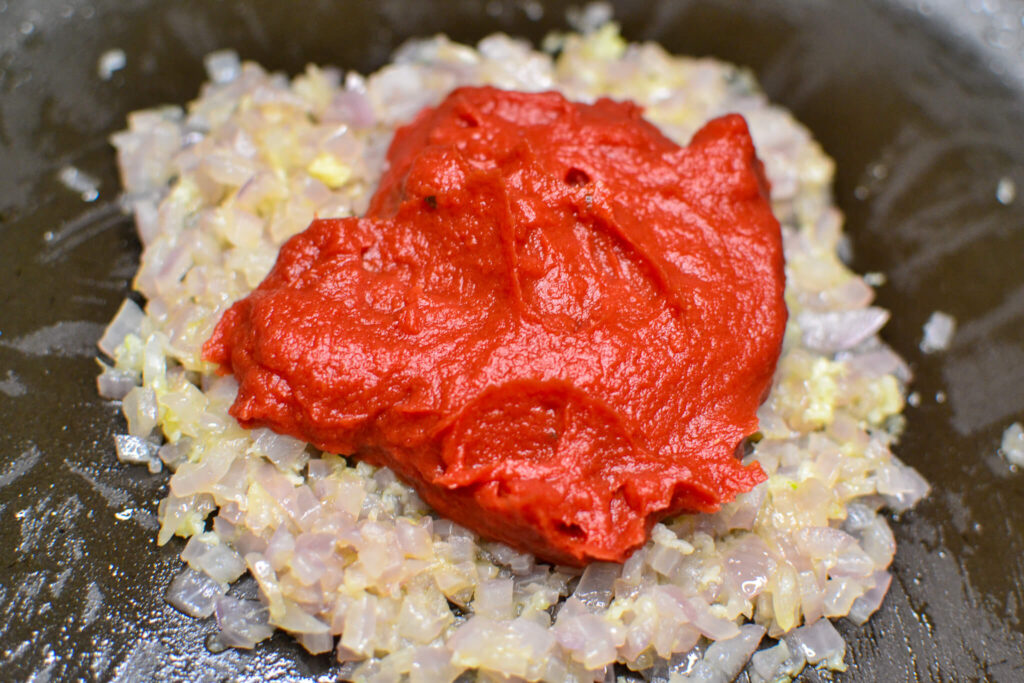
Now, it’s time to transform this base into vodka sauce. Add a few tablespoons of tomato paste to the skillet. Cooking it down for about 3 minutes will intensify its sweet, tangy, and umami-rich profile. The paste will thicken, darken, and develop a deeper flavor as it caramelizes.

Next, pour in 1/2 cup of vodka—my personal favorite is Tito’s. Deglazing with vodka not only adds a unique depth of flavor but also helps lift the flavorful browned bits from the bottom of the skillet. Cook the vodka for about 3 minutes to allow the alcohol to evaporate, leaving behind its subtle taste.

Now, stir in 1 cup of heavy cream. As you continue to cook on medium heat, the sauce will take on a beautiful orange hue.

Season with 1/2 tsp crushed red pepper flakes, 1/2 tsp paprika, 1/2 tsp salt, and 1/2 tsp pepper.

Before adding the Parmesan, pour in the reserved pasta water, about 2/3 cup, to loosen the sauce. The starches in the water help to emulsify the sauce, making it silky and ensuring it clings to the pasta perfectly.
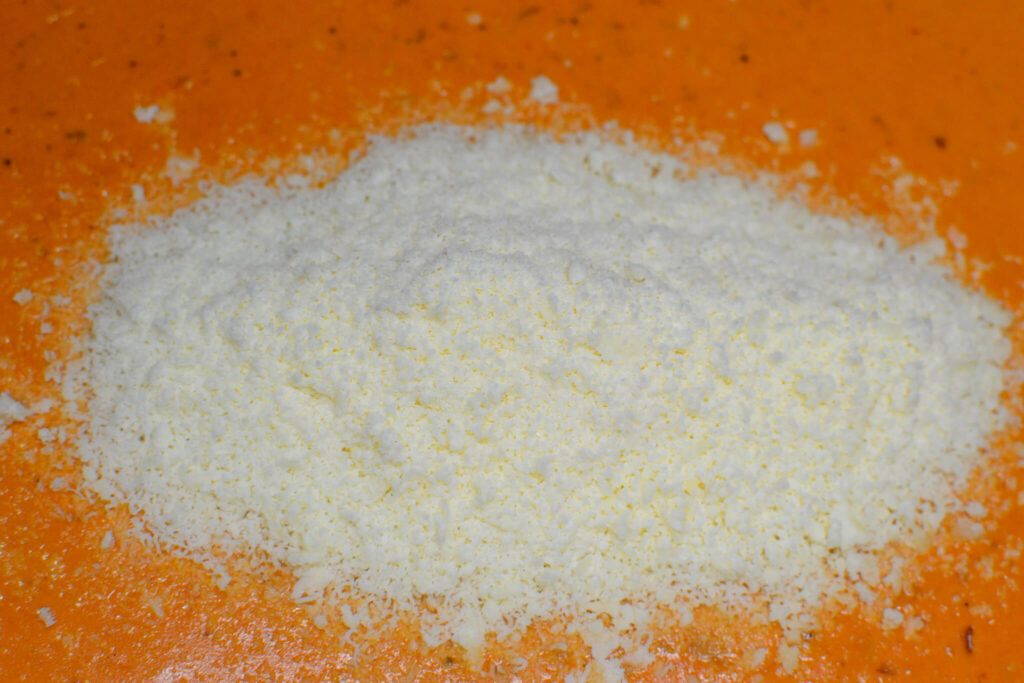
Once the sauce has reached the desired consistency, add 1/2 cup of freshly grated Parmesan cheese. Fresh Parmesan melts seamlessly, adding a rich, nutty flavor that elevates the sauce to perfection.

To finish the sauce, stir in a handful of freshly chopped basil. The basil brings a subtle sweetness and herbal freshness that balances the boldness of the vodka and the heat from the crushed red pepper flakes. Its fragrant, slightly sweet notes cut through the richness of the cream and cheese, adding a layer of complexity to the dish. The basil not only enhances the flavor but also adds a pop of color, making the sauce as visually appealing as it is delicious. This final touch ties all the elements together, creating a well-rounded and harmonious vodka rigatoni.
Step 4
Combine

Now it’s time to bring the pasta and sauce together. Add the cooked rigatoni to the skillet and gently stir until each piece is thoroughly coated. Let the pasta sit for a minute or two in the sauce, allowing it to absorb the rich flavors. The rigatoni’s ridged texture will grab onto the sauce, ensuring every bite is packed with creamy, savory goodness.

Give the dish a final taste and adjust the seasoning if necessary. A little extra salt or freshly ground black pepper can make all the difference in achieving the perfect flavor balance.
Step 5
Enjoy Your Vodka Rigatoni!

Once your pasta is perfectly sauced, plate it up and garnish with an extra sprinkle of Parmesan cheese and a few fresh basil leaves. The Parmesan adds a layer of savory richness, while the basil brings a pop of color and a fragrant, herbal note that complements the creamy sauce beautifully. This final touch not only enhances the flavor but also makes the dish look as good as it tastes. Now, it’s time to dig in and savor every creamy, flavorful bite of your homemade vodka rigatoni.

Sharp Objects

Inspiration
Camille’s Drinking Problem

More About Vodka Rigatoni

Vodka Rigatoni
Equipment
- 1 Skillet
- 1 Pot
- 1 Strainer
- 1 Grater
Ingredients
Produce
- 1 red onion
- 3 garlic cloves
- fresh basil
Refrigerated
- 1 cup heavy cream
- 1/2 cup parmesan cheese
Grocery
- 1/4 cup vodka
- 6 oz tomato paste
- 1/4 cup olive oil
- 16 oz rigatoni
Spices
- 1/2 tsp crushed red pepper flakes
- 1/2 tsp paprika
- 1/2 tsp salt
- 1/2 tsp black pepper
Instructions
Cook the Pasta
- Bring a large pot of salted water to a boil. Cook the rigatoni until al dente, about 10-15 minutes.
- Reserve 2/3 cup of pasta water before draining.
Prep the Produce
- Dice the red onion, mince the garlic, and chop the basil. Set aside
Make the Sauce
- Heat olive oil in a skillet over medium heat.
- Add diced red onion and sauté for about 3 minutes until translucent.
- Stir in minced garlic and cook until fragrant.
- Add tomato paste and cook for 3 minutes, allowing it to caramelize.
- Add Vodka and cook for 3 minutes.
- Stir in heavy cream and season with red pepper flakes, paprika, salt, and black pepper.
Incorporate Pasta Water and Cheese
- Add reserved pasta water to the sauce and stir well to combine.
- Mix in freshly grated Parmesan cheese until fully melted and incorporated.
Combine Pasta and Sauce
- Add the cooked rigatoni to the skillet and gently stir until each piece is coated with the sauce.
- Let it sit for a minute to absorb the flavors.
Add Basil and Serve
- Stir in chopped basil for a fresh, sweet balance.
- Serve hot, garnished with extra Parmesan and basil, if desired.
There can be multiple pronunciations of Vodka Rigatoni because it is an Italian dish that may be pronounced differently in different regions of Italy, and also in different parts of the world where the dish is popular.
Italian is a language with many regional variations, and different regions of Italy may have different dialects, accents, and pronunciations. This may be pronounced differently in the north of Italy than in the south, for example.
Other people refer to this recipe as “vodka a la rigatoni” because in Italian it essentially means “Vodka in the style of Rigatoni.”
The pronunciation of Italian dishes can also be influenced by the local language and accent of the region where the dish is being prepared. For example, in the United States, the pronunciation of Vodka Rigatoni may be influenced by the local dialect or accent, and may sound different than it would in Italy.
There variations in pronunciation simply due to personal preference or individual interpretation. Some people may pronounce the dish with a more Americanized accent, while others may try to adhere to a more authentic Italian pronunciation.

